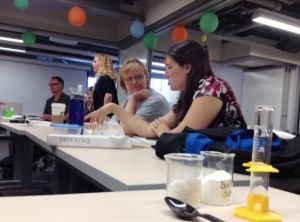“We’ve seen lab work disappear from our classrooms, and it’s almost like we’ve been given permission to do lab work.” Spalding said. “The science courses of old were like ‘learn the history of science’ and now we’re saying ‘do the work of science.’ ”
Under the new requirements, teachers and students would cover less material. Instead, they'd go more in-depth on topics such as climate change, biological evolution and engineering design. Students, in turn, would plan and carry out investigations, conduct experiments and build models.
Tammy Cook-Endres, a teacher and coordinator at the Exploratorium's Teacher Institute, said the new standards would mean more work for educators but the lessons would be more engaging for students.
“This is really hard to do. These [standards] are ambitious … and we’re going to need to support teachers … and I think that is why we’re starting to have these conversations.” Cook-Endres said.
California is not alone. Twenty-five other states are also making the switch. National test scores show students across the country are performing poorly in science and math. That's bad news for California, considering a large part of the state's economy is based on science, technology and engineering.
For their part, the teachers who are training here at the Exploratorium say they are eager to get a firm grasp of the new standards so they can mentor their fellow educators. One way they're doing that is by taking on the kind of activities their students would do in the classroom.
One lab activity required teachers to mix salt, baking soda and water in a plastic baggy to show how a chemical reaction involving two solid materials can produce a gas. The teachers busily filled out a report documenting the process. The result was a kind of mini-research paper that students will have to produce with almost every activity they do.
Ariel Owens teaches earth and life sciences in Walnut Creek. She said students will have to think more critically, but they learn best when they see something, feel it and hear it.
“I think the engineering standards demonstrate that not only is (engineering) not too hard to do, it’s fascinating. It’s the best part of science … that’s the heart of it.” Owens said.
But not everyone is as enthusiastic.
Some education policy experts say the new standards omit important core science content. There are also questions about how much more districts will have to spend to implement the new standards, how many teachers will embrace the change, and what the curriculum and tests will ultimately look like.
Teachers across California, however, say this is one experiment they're willing to take on.
If, as expected, the state Board of Education approves the Next Generation Science Standards at their meeting, the standards would take effect in 2015.
Note:
Over the next two years, 20,000 California public school teachers annually will receive free admissions to the Exploratorium in San Francisco. The program runs July 1, 2013 - June 30, 2014 and July 1, 2014 - June 30, 2015 with a total of 40,000 teachers to receive free admissions. To receive the free tickets, teachers need to register online at http://www.exploratorium.edu/visit/teachers.
